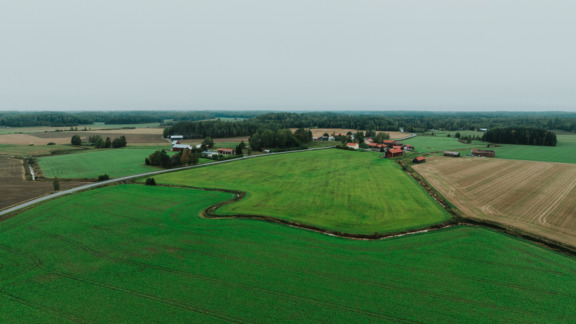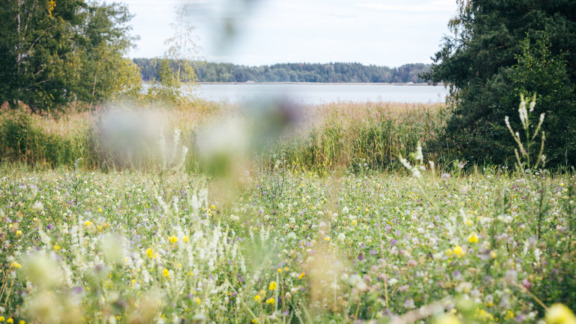SUMANU: Circular Economy in Agriculture seminar
Circular Economy in Agriculture -seminar
Finlandia Hall, Helsinki, Finland 30/9/2019
Set objectives high and coordinate joint actions to reach them
The above summarizes the conclusions of the panel discussion on the sustainable use of livestock manure during the Finnish EU Presidency Circular Economy warm-up event in Helsinki, Finland.
SuMaNu Interreg platform project and Baltic Sea Action Group (BSAG) arranged a seminar titled “Circular Economy in Agriculture – How to Advance Nutrient Circulation, Soil Quality and a Healthy Environment.” at Finlandia Hall on the 30 September 2019. The event was part of the Finnish EU Presidency event European Days for Sustainable Circular Economy (#edsce19). Approximately 40 people, from small producers to politicians, took part and enjoyed a fruitful panel discussion, in which sharing their views were MEP Sirpa Pietikäinen, Professor Jean-Franҫois Soussana from the French National Agricultural Research Institute INRA, Director Juha Nousiainen from the Finnish dairy company Valio, Senior Ministerial Adviser Saara Bäck from the Finnish Ministry of the Environment and Senior scientist Sari Luostarinen from Natural Resources Institute Finland (Luke). The panel discussion was moderated by Researcher Erik Sindhöj from RISE, Sweden.

The introductory presentations came from research and administration. The opening address was given by Minna Sarvi, Research Scientist at Luke and the coordinator of the SuMaNu platform project. She referred to HELCOM statistics and noted that in land-based phosphorus load to the Baltic Sea, distinct regional peaks stand out. As a result of emission reductions from waste water treatment plants and industry, the diffuse load from agriculture, and in particular the contribution of certain regions with accumulated phosphorus, is accentuated. In these areas, accumulation of phosphorus in animal manure exceeds the needs of the region’s crop production. Regional concentration reflects the nature of the challenge, being connected to the structure of the agricultural sector and its value chains.
The case presented about Finland exemplifies this. According to Luke, 26 000 tonnes of potentially recyclable phosphorus is produced each year, of which 19 300 tonnes in livestock manure (figures by Luke from 2017). At the same time, 11 000 tonnes of mineral phosphorus are used in Finnish agriculture annually. To make manure phosphorus a more viable alternative to replace mineral phosphorus as a fertilizer, the excess manure should be processed so that it can be more easily transported to areas where it is needed.
The aim of the SuMaNu platform project is to pool information and produce recommendations on how to improve the efficiency of manure utilization both at farm and regional levels, so that manure nutrients can be used more efficiently and safely in crop production.

The intergovernmental environmental policy body of the Baltic Sea countries, HELCOM, has accelerated efforts to solve the challenges of nutrient run-off and nutrient recycling through a joint regional nutrient recycling strategy. In her introductory remarks, Saara Bäck, Senior Ministerial Adviser and the current Chairman of HELCOM, remided that 98% of the Baltic Sea still suffers from eutrophication. In Finland, the work to promote nutrient recycling started already in 2010, when Prime Minister Matti Vanhanen set the goal of making Finland a model country for nutrient recycling by 2020. To achieve this goal, several funding programs have been implemented, such as the Finnish government key project on nutrient recycling launched in 2016.
For the basis of the HELCOM regional nutrient recycling strategy, work to establish guidelines for standards to determine the nutrient content of manure is ongoing. The standards are currently being developed by Manure Standards, a joint project of the Baltic Sea countries, which is also involved in SuMaNu. Another example of national initiatives is the national phosphorus strategy in Germany.
The objectives of HELCOM’s regional nutrient recycling strategy were jointly agreed between the countries last summer. They set focus on sustainability and safety, reducing the environmental load and creating new business opportunities. The objectives of the strategy will be implemented through the HELCOM Baltic Sea Action Plan and nationally through relevant policies. Once completed, this would present the Baltic Sea region as a model area for nutrient recycling.
In her presentation, Senior Researcher Sari Luostarinen of Luke, a specialist in manure management and processing, summed up the key policy issues for the panel to tackle. As the regional segregation of crop and livestock production results in phosphorus surpluses in some areas and in deficit in others, it is necessary to look for solutions beyond the farm scale to achieve a more even use of manure nutrients, meaning also less nutrient runoff to the waters. Since transportation of raw manure is expensive and inefficient, part of the manure produced should be processed into more advanced recycled fertilizer products. This would mean, in particular, the separation of nitrogen and phosphorus into different fractions and the concentration of the nutrients into smaller volumes using different technologies. The organic matter in the manure is important for maintaining soil fertility and often the manure phosphorus ends up in the same processed product with the organic matter.
In terms of policy steering, the promotion of manure processing requires the development and quality assurance of the manure-based fertilizer products, as well as financial support and incentives to promote the emergence of larger processing plants as ‘regional nutrient recycling centres’. It is essential to target policies specifically to address regional imbalances in nutrients and to encourage the farmers to use recycled nutrients instead of mineral fertilizers.
The main part of the event, the panel discussion, provided an excellent, constructive and positive discussion on managing agri-environmental issues from multiple angles. Jean-Franҫois Soussana, a merited climate scientist and contributor to the 4-per-mille initiative by France at the 2015 Climate Summit, stressed that soil carbon plays a key role in the behaviour of nitrogen and phosphorus. The optimum carbon-nitrogen-phosphorus ratio ensures that the phosphorus remains in the soil and is not subject to leaching. Soil carbon and soil carbon storage play an important role in mitigating climate change and therefore the issue of nutrient recycling, manure use and water protection should be considered in conjunction with soil carbon and climate issues. From the climate perspective, also the entire food system should be addressed, which, depending on how it is calculated, accounts for more than a third of all greenhouse gas emissions, as Professor Soussana pointed out. In this case, one should critically consider e.g. the use of fossil energy, diet and eating habits; land use, and, above all, the promotion of nature-based, multi-benefit solutions such as restoring soil microbiology and farming methods which circulate organic material. This is not only about combating climate change, but also preparing for and increasing resistance to climate change and extreme weather events.
In recent years, we have seen many examples of how companies have taken initiatives to transform their operations more climate friendly, realizing that it may be also commercially smart to be among the early adaptors. A good example of this kind of thinking and goal setting is Valio Ltd, represented in the panel by Juha Nousiainen, Director of the Carbon Neutral Milk Chain. When he was recently commented that pursuing carbon-neutral milk production by 2035 is “absolutely crazy”, Nousiainen replied:”Is it really crazy enough?”. He firmly believes that targets need to be set beyond what is currently seen technically feasible. According to Nousiainen, Valio’s target will be achieved through the means currently being explored and disseminated more widely: soil management, storage of atmospheric carbon dioxide via grasslands, on-farm and regional manure processing solutions, reduction of mineral fertilization, and the abandonment of fossil fuels.
The panel also considered the health risks associated with the use of recycled fertilizers in food production, such as cadmium and other harmful metals, as well as antibiotics and antibiotic resistant microbes. The new EU fertilizer product regulation also covers product safety issues, but there are many unknowns, so research and monitoring to minimize these risks need to be continued.
Once the targets are set and the private and public goals aligned, well-targeted smart regulation is needed to steer multiple actors simultaneously towards the target. In the debate, MEP Sirpa Pietikäinen called for a shift away from sectoral thinking and emphasized systemic change, which can also be achieved through targeted incentives. In particular, agriculture should be linked to a broader food system. Why not start to draw a road map for a sustainable food system in Europe?
This discussion, too, showed that we can, in any case, increase communication and debate between different sectors. As Saara Bäck emphasized, open information sharing and confidence-building discussion open up opportunities for mutually beneficial solutions.
Background: The structure of agriculture feeds phosphorus hot spots
The regional segregation of animal and crop production is a problem both in Finland and in Europe in general. In Central and Western Europe, the issue was first raised because of groundwater pollution caused by nitrate emissions, but the Baltic Sea region and Finland are equally concerned with phosphorus. This approach is increasingly being adopted around Europe.
In general, livestock manure contains too much phosphorus relative to nitrogen and crop needs. Phosphorus is a non-renewable resource whose production raises worrying ecological, socio-economic and geopolitical issues. Together with nitrogen, it accelerates eutrophication when entering waterways. But in the soil, phosphorus is a vital nutrient for crops. The correct chemical balance between nitrogen, phosphorus and carbon promotes nutrient entry into crop growth and prevents leaching to waterways.
This equilibrium has been disturbed in many places: in Finland, the problem is the regional segregation of livestock production and the history of high phosphorus fertilization increasing the soil phosphorus stock occurring on the same regions. Manure phosphorus is available on areas with little need for phosphorus fertilization. In France, the problem is exacerbated by the import of soya, which leads to the concentration of livestock production in coastal areas close to ports. This makes sustainable uses of nutrients more challenging. For well-functioning, living soils, and to combat climate change, we should find ways to simultaneously recycle nutrients and add carbon to the soil and keep it there. Optimal use of manure is also part of this solution.



